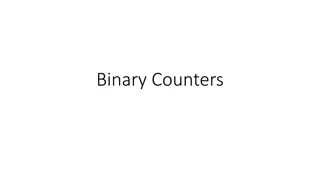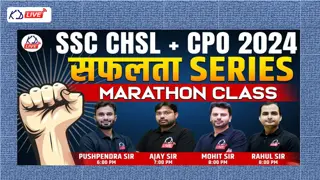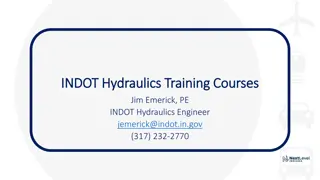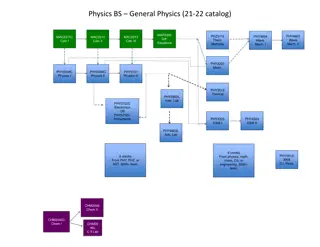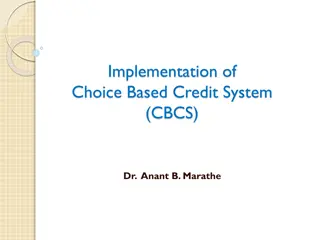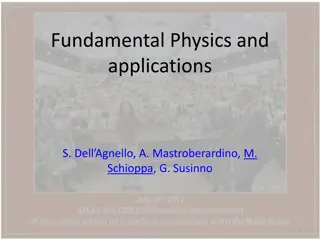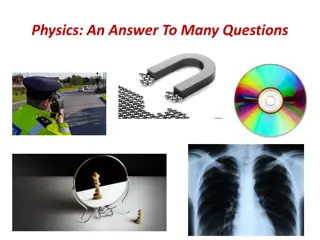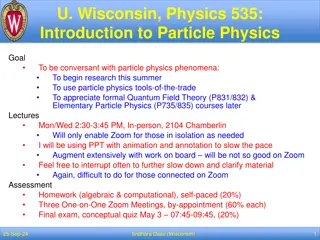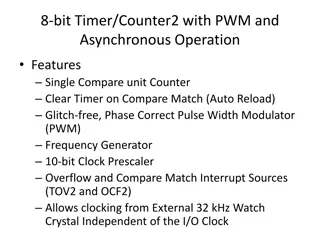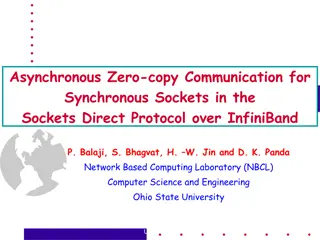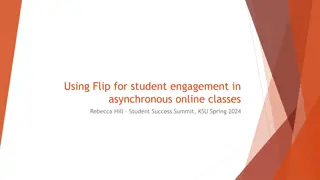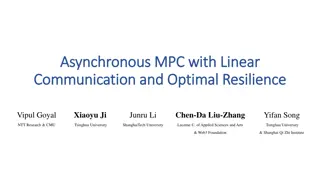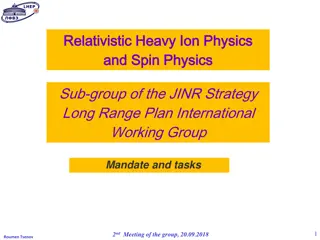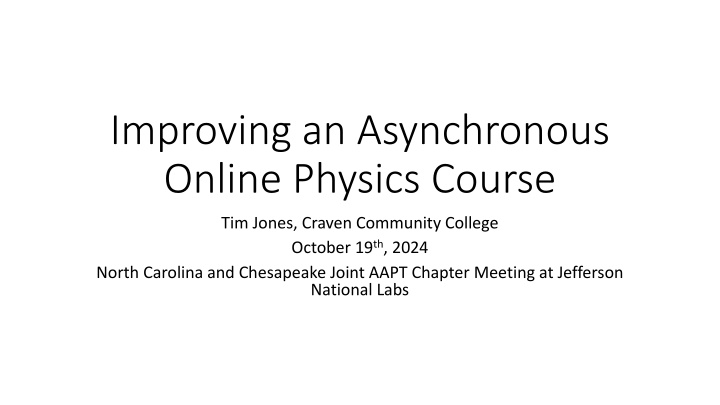
Improving Asynchronous Online Physics Course: Challenges and Solutions
Discover effective strategies for enhancing an asynchronous online physics course, including addressing challenges with collaborative activities, math input, lab kits, forums, and combatting cheating in tests. Explore organizational rubrics, learning management system ideas, external tools/software, and methods for maintaining academic integrity in online assessments.
Download Presentation

Please find below an Image/Link to download the presentation.
The content on the website is provided AS IS for your information and personal use only. It may not be sold, licensed, or shared on other websites without obtaining consent from the author. If you encounter any issues during the download, it is possible that the publisher has removed the file from their server.
You are allowed to download the files provided on this website for personal or commercial use, subject to the condition that they are used lawfully. All files are the property of their respective owners.
The content on the website is provided AS IS for your information and personal use only. It may not be sold, licensed, or shared on other websites without obtaining consent from the author.
E N D
Presentation Transcript
Improving an Asynchronous Online Physics Course Tim Jones, Craven Community College October 19th, 2024 North Carolina and Chesapeake Joint AAPT Chapter Meeting at Jefferson National Labs
Agenda Examples of Challenges Organizational Rubric Learning Management System ideas Useful external tools and software Combating cheating in online tests Other ideas Unimplemented ideas Sources
Challenges Implementing interactive activities (such as peer review) between students Easy student input of math in a quickly gradable form Overpriced lab kits Forums which are either transactional, off topic, or unwieldy to grade Students will be collaborating with each other and chatGPT, whether you want them to or not
Organizational rubric (from Quality Matters) Quality matters Review Standards 1. Course overview and introduction Where to start, what are the requirements, introductions 2. Learning objectives 3. Assessment and measurement 4. Instructional Materials 5. Learning activities and learner interaction 6. Course technology 7. Learner support Links to school s technical support, accessibility and accommodation policies, academic support services, and other institutional resources 8. Accessibility and usability Review standards from Quality Matters are available NC community college faculty can get a faculty stipend for a program implementing the standards in an online course Has some flexibility, but is still a rubric evaluating your course Stopped having questions from students about how the course worked
Learning Management System (LMS) ideas It is possible to add functionality to Moodle by searching through plugins (many are free): https://moodle.org/plugins/ For example, the formula and freehand (ETH) plugins can be useful Inserting a python shell into your LMS using trinket.io can be handy
External tools and software Tracker: https://physlets.org/tracker/ Noragulfa tools (by Geoff Nunes): Nplot: https://noragulfa.com/nPlot/ Sigmund video analysis: https://noragulfa.com/sigmund/ A free particle (by Michael Freeman): https://sites.google.com/view/afreeparticle/interactives Perusall: https://www.perusall.com/ Using OER books (except openstax) with Perusall is free
Combating cheating in online tests Change multiple things at once Require lockdown browser with webcam Include short answer questions mixed with randomized numerical questions Don t allow students to browse through all questions, have them work on a randomized subset of the questions Include similar questions (to others or past questions) with small changes Grades on test questions went down by about 10 percentage points as a result
Other ideas Ask more sketching-related questions to better evaluate root understanding Grade by the argument of the question rather than the answer Grading line:
Unimplemented ideas Weighting questions in a test based on the number of students getting the question correct (more students getting correct the less it s worth down to a minimum value) Former colleague math teacher (Ben Doremus) did this, which removed the typical bimodal grade distribution Worked well in conjunction with standards based grading All grades were kept in an excel sheet Gave concrete problem types for students to work on Made grade report comments and parent conferences easy and objective Asking questions which aren t questions (context-dependent statements) Using H5P Branching scenario using video, powerpoint, images, or text. Branching controlled by multiple choice questions (similar to interactive video vignettes in Compadre)
Sources Item Source Quality Matters higher education rubric https://www.qualitymatters.org/sites/default/files/PDFs/Standardsfromt heQMHigherEducationRubric.pdf Moodle formula plugin documentation https://dynamiccourseware.org/course/index.php Moodle freehand (ETH) plugin https://moodle.org/plugins/qtype_drawing Trinket trinket.io Tracker https://physlets.org/tracker/ Noragulfa nplot https://noragulfa.com/nPlot/ Noragulfa video analysis https://noragulfa.com/sigmund/ A free particle (desmos simulations) https://sites.google.com/view/afreeparticle/interactives Perusall (commenting on texts) https://www.perusall.com/ Learning to Think like a Physicist: A Review of Research-based Instructional Strategies (source talks about diagrams helping physics understanding) American Journal of Physics 59, 891 (1991); doi: 10.1119/1.16667 Weighting questions by difficulty Discussions with Ben Doremus in 2016 Asking questions which aren t questions From 2023 OPTYCs NFDS workshop sessions led by Dwain and Angela H5P branching scenario https://h5p.org/branching-scenario Interactive Video Vignettes https://www.compadre.org/ivv/

